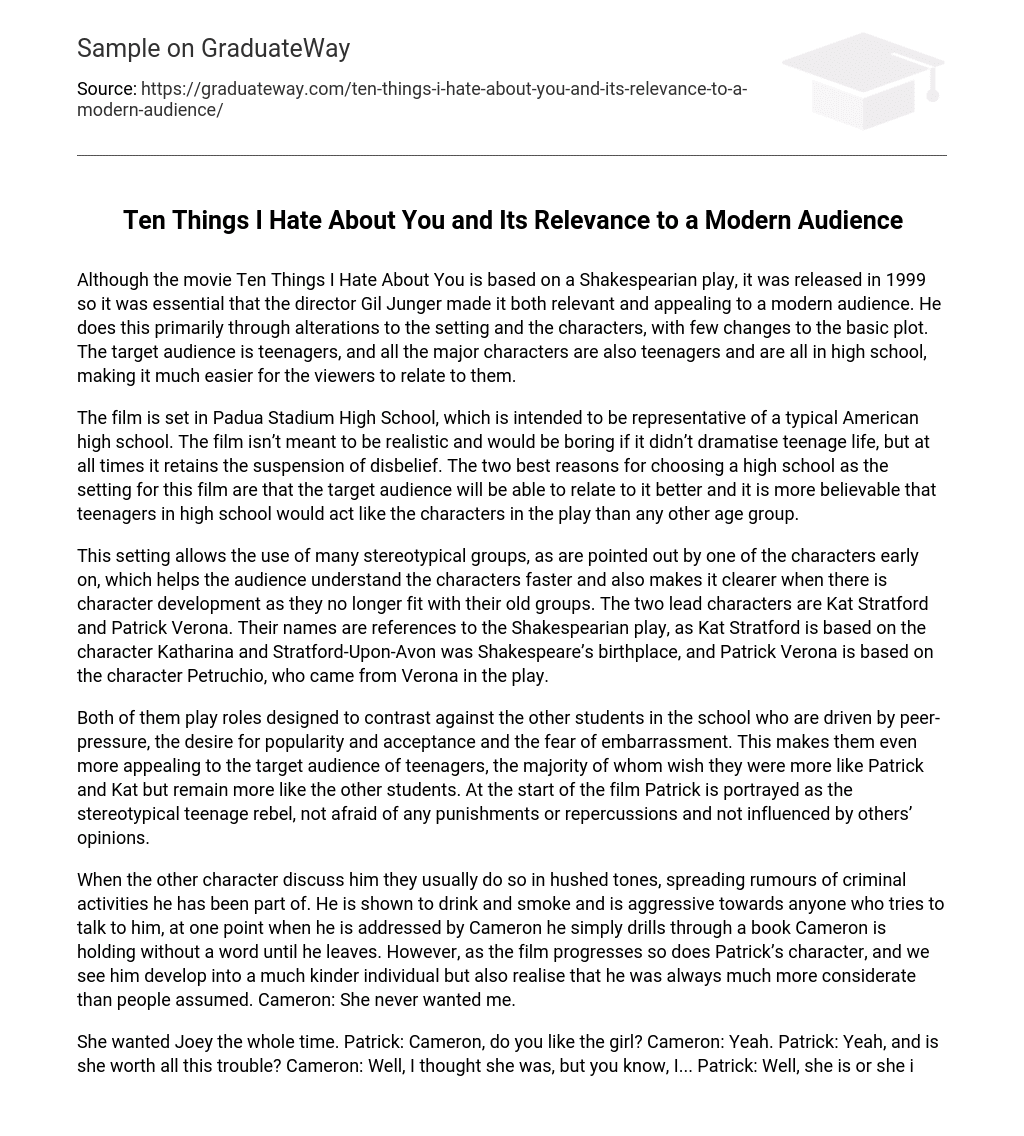Despite being based on a Shakespearian play, the movie Ten Things I Hate About You was released in 1999. Therefore, it was crucial for the director, Gil Junger, to make it relevant and appealing to a modern audience. To accomplish this, Junger primarily focused on modifying the setting and characters while keeping the basic plot intact. The film’s target audience is teenagers, and all the main characters are also teenagers attending high school. This deliberate choice enables viewers to easily connect with the characters on screen.
The film is set in Padua Stadium High School, a representation of a typical American high school. While not aiming for realism, the film effectively dramatizes teenage life while maintaining the suspension of disbelief. The choice of a high school setting is justified by two primary reasons: relatability to the target audience and the believability of high school teenagers acting like the characters in the play, compared to other age groups.
The usage of various stereotypical groups in this setting, as mentioned by one of the characters early on, assists the audience in quickly comprehending the characters and allows for easier recognition of character development when they no longer align with their initial groups. The main characters, Kat Stratford and Patrick Verona, have names that reference the Shakespearian play. Kat Stratford is inspired by the character Katharina, while Stratford-Upon-Avon was Shakespeare’s birthplace. Similarly, Patrick Verona draws from the character Petruchio, who hailed from Verona in the play.
Both Patrick and Kat have contrasting roles in relation to their peers at school. While their classmates are motivated by peer-pressure, the longing for popularity and acceptance, and the fear of being embarrassed, Patrick and Kat stand out by not conforming to these norms. This uniqueness makes them even more attractive to the teenage target audience. Most teenagers aspire to be like Patrick and Kat, but in reality, they resemble the majority of their classmates. At the beginning of the film, Patrick is depicted as the typical teenage rebel, unafraid of punishment or consequences, and unaffected by others’ opinions.
Other characters often speak about him in hushed tones, circulating rumors of his participation in illicit deeds. He is portrayed as an individual who indulges in alcohol and tobacco, displaying hostility towards anyone who dares to approach. A notable incident occurs when Cameron attempts to converse with him; Patrick silently bores a hole through the book that Cameron is clutching until he retreats. Nevertheless, as the movie unfolds, Patrick’s persona undergoes a transformation into someone considerably more empathetic. It becomes evident that he possessed a greater level of thoughtfulness than people initially acknowledged.
Cameron: She never wanted me.
Joey was desired by Kat throughout. Patrick asked Cameron if he is interested in the girl, to which Cameron confirmed. Then Patrick questioned if all the trouble was worth it, to which Cameron replied that he thought so but wasn’t entirely sure. Patrick stated that the girl either is or isn’t worth it, pointing out that Joey is inferior to Cameron. He also advised Cameron not to let anyone make him feel unworthy of what he desires and encouraged him to go for it. Kat Stratford possesses similar rebellious qualities as a character. Her notable trait is fearlessly expressing her opinions, regardless of how unpopular or controversial they may be.
In one instance, she asserts that expressing her opinion does not equate to terrorism. As a feminist, she primarily embraces underground feminist punk music, which embodies her opposition to commercialism and mainstream culture. Similar to Patrick, she undergoes significant character growth throughout the movie, ultimately attending the prom with him despite initially ridiculing it and perceiving it as meaningless. Another pivotal character is Cameron James, who starkly contrasts with Patrick.
Patrick is rough, aggressive, and tough, while Cameron is kind and sensitive. Despite warnings from Michael, who was assigned to guide him around the school, Cameron becomes infatuated with Bianca from his very first day at Padua High. Michael describes Bianca as a snotty princess who dresses strategically to make guys like them realize they can never have her. However, Cameron’s viewpoint changes as he matures throughout the film. He gains the strength of character to stand up for himself and express his thoughts. At the beginning, he goes to great lengths, such as learning French, to get Bianca’s attention. However, in the second half of the movie, Cameron’s character develops enough for him to tell Bianca that her beauty doesn’t give her the right to mistreat others.
While the construction of this movie incorporates various film codes and narrative techniques, characterisation and setting are possibly the most crucial elements in terms of its significance and attraction to a contemporary audience. The film’s setting in a high school and its focus on teenage characters facing relatable issues, though exaggerated, make it particularly enjoyable for teenagers. Through adept utilization of available techniques, Junger has effectively transformed a Shakespearian play into a relatable and appreciable work for a modern audience.





